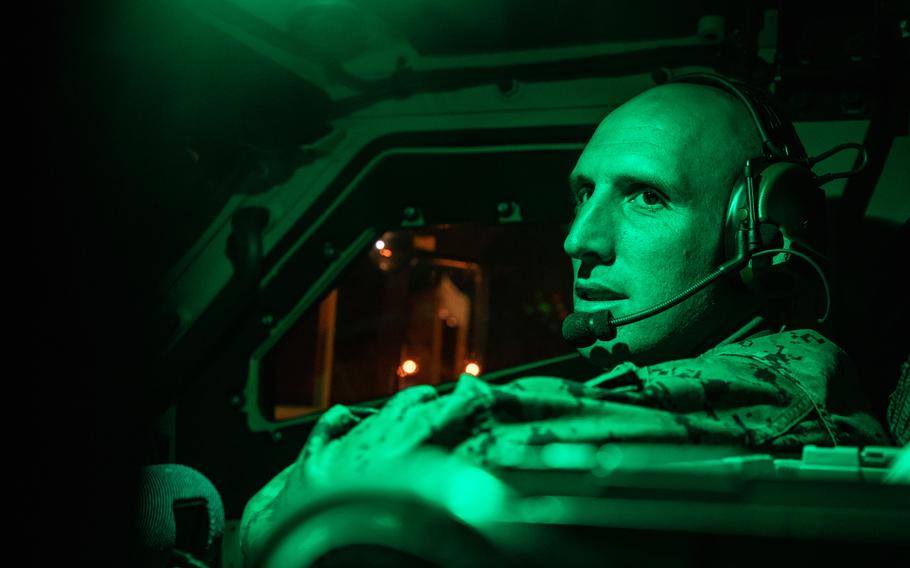
Marine Staff Sgt. Coltin Davenport, regimental communications chief, performs radio checks in a joint light tactical vehicle on Naval Support Activity Mid-South, Tenn., May 6, 2021. Marines in tactical vehicles and trucks drove from Camp Lejeune, N.C., to Twentynine Palms, Calif., in one of the longest convoys in Marine Corps history. ( Scott Jenkins/U.S. Marine Corps)
The Marines have a line of trucks rolling across the U.S.A. as part of a test of radio communications systems tactics — but they’re not on the citizens band.
The convoy headed west out of Camp Lejeune on a four-week, 5,000-mile roundtrip mission in early May, the 2nd Marine Logistics Group said. It drove to Twentynine Palms, Calif., and was on its way back home Wednesday, a spokesman said.
Along the way, the Marines in this 18-vehicle column have “experimented with tactics and procedures” for using high frequency radio systems to coordinate over vast distances.
Unlike the truckers on CBs in the 1970s hit song “Convoy,” the Marines in trucks and tactical vehicles are using AN/PRC-150 “man pack” radios equipped with encryption. They’re able to connect back to Lejeune from stops in places like Millington, Tenn., Albuquerque, N.M., and Williams, Ariz. They stopped to see the Grand Canyon too.
The HF range from 3 and 30 megahertz has a history of use in the Marine Corps “going all the way back to the Navajo Code Talkers on Iwo Jima,” said Staff Sgt. Coltin Davenport, regimental communications chief for Combat Logistics Regiment 2, as quoted in the 2nd MLG statement.
But it was largely considered “dead” amid the development of satellites, microwave antennas and fiber optics. Still, the ability to bounce HF waves off the upper atmosphere allows for transmission past mountains and the curvature of the Earth, an advantage over frequencies that need a clear line-of-sight path.
The use of HF “allows us to communicate over great distances without having to rely on other methods that the enemy can detect,” Davenport said.
Their relative low-cost, reliability and ease of use has also made HF radios a favorite for criminals, drug traffickers and terrorists, said the National Security Agency’s Cryptologic Quarterly in a 1992 report. It predicted that HF would long remain useful to “great powers,” developing nations and illicit enterprises.
Last year, the Marine Corps awarded a $380 million contract to Rochester, N.Y.-based L3Harris Technologies Inc. to modernize its HF radios over five years to meet new NSA requirements for protecting top secret and less sensitive voice and data from enemy snooping.
The wideband-HF systems provide “long-haul communications, and the primary backup … in a satellite communications-denied environment,” Marine Corps Systems Command project officer Leigh King said in a statement about HF upgrades last May.
As for the cross-country trek, it may be the longest haul in the history of Marine Corps convoys, officials say, and by a long shot. In November, Combat Logistics Regiment 27 clocked a 916-mile convoy from Fort Drum, N.Y. to Lejeune, thought to be among the longest on record.
“This convoy, at more than twice the length on the initial leg alone, obviously surpasses that,” said 2nd MLG spokesman Capt. Robert A. Vachon in an email Wednesday. “We’re still working to validate whether or not this is in fact the longest, but from our research, it almost certainly is.”
It’s been running smoothly so far, Capt. Adam Devine, the convoy commander, said in a statement.
Twitter: @chadgarland